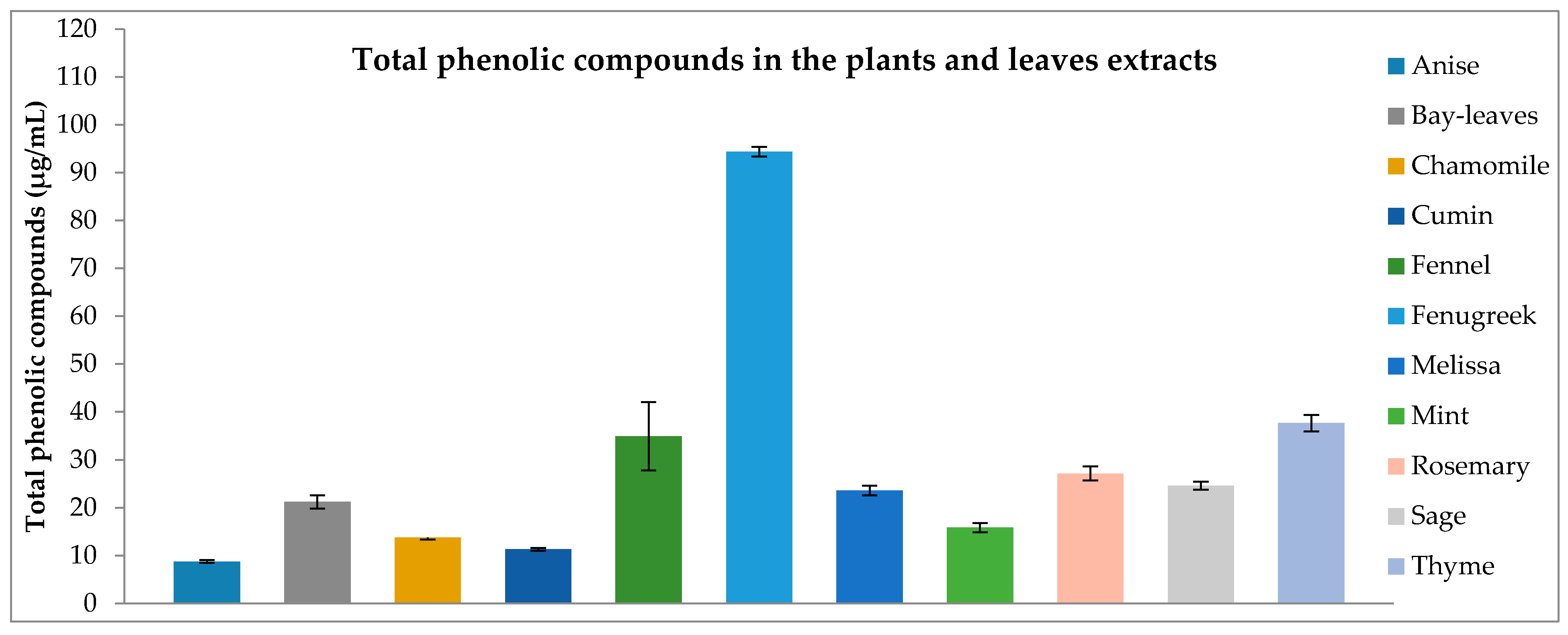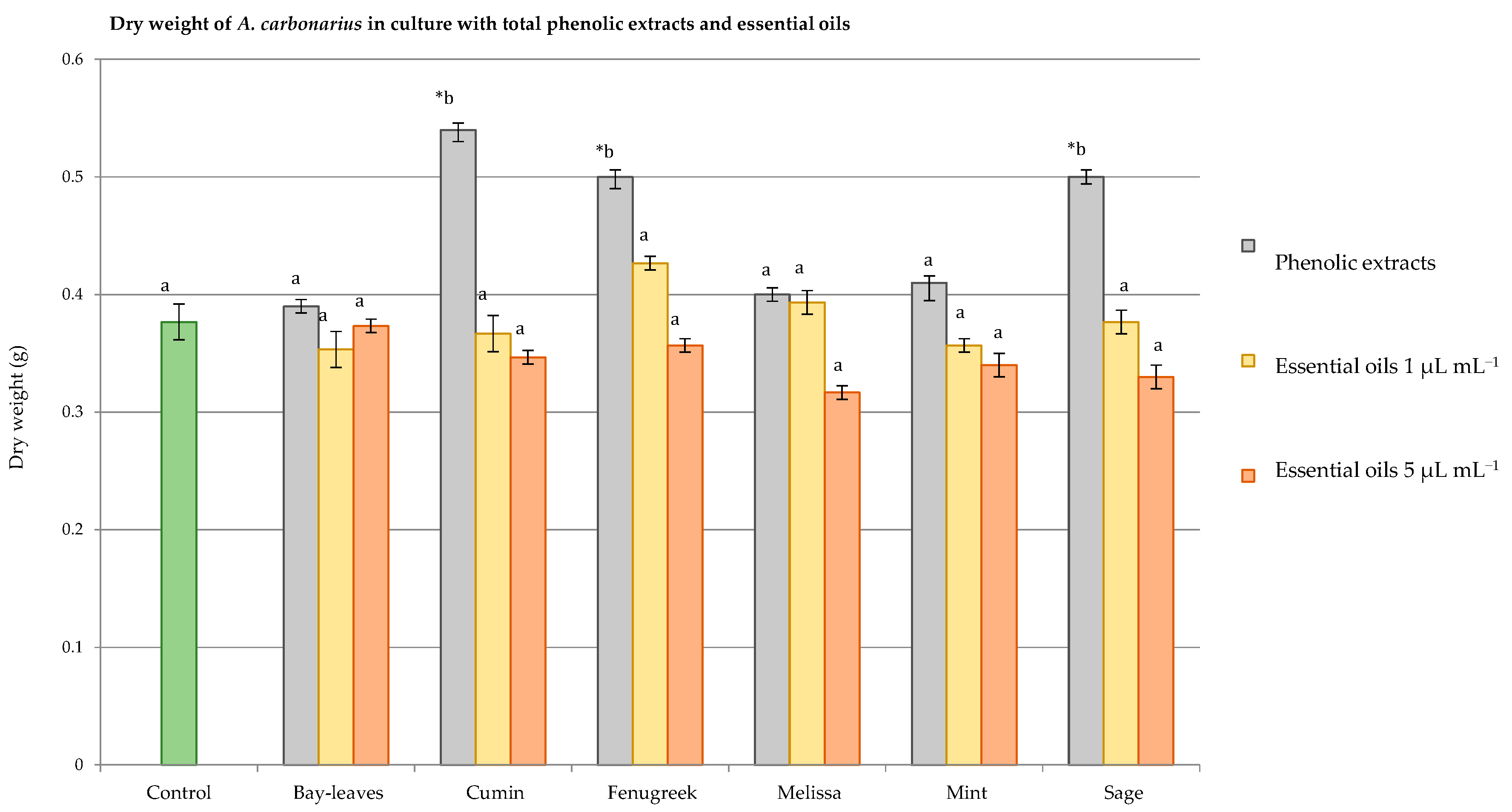Antifungal and Antiochratoxigenic Activities of Essential Oils and Total Phenolic Extracts: A Comparative Study
Abstract
:1. Introduction
2. Materials and Methods
2.1. Plant Material
2.2. Extraction of Phenolic Compounds from Medicinal Plants
2.3. Quantification of the Extracted Phenolic Compounds
2.4. Strains and Culture Conditions
2.5. Growth, Fungal Weight Analysis, and Morphological Alteration of A. Carbonarius S402
2.6. OTA Extraction and HPLC (High Proficiency Liquid Chromatography) Analysis
2.7. Statistical Analysis
3. Results
3.1. Phenolic Content of the Extracts
3.2. Comparison between Six Essential Oils and Phenolic Extracts on the Radial Growth of A. Carbonarius S402
3.3. Morphologic Changes in A. Carbonarius Cultured with EOs and Phenolic Compounds
3.4. Comparison between Phenolic Extracts and Essential Oils on Dry Weight and OTA Production
4. Discussion
5. Conclusions
Acknowledgments
Author Contributions
Conflicts of Interest
References
- Park, J.W.; Chung, S.H.; Kim, Y.B. Ochratoxin a in korean food commodities: Occurrence and safety evaluation. J. Agric. Food Chem. 2005, 53, 4637–4642. [Google Scholar] [CrossRef] [PubMed]
- Pietri, A.; Bertuzzi, T.; Pallaroni, L.; Piva, G., IV. Occurrence of ochratoxin A in italian wines. Food addit. Contam. 2001, 18, 647–654. [Google Scholar] [CrossRef] [PubMed]
- Overy, D.P.; Seifert, K.A.; Savard, M.E.; Frisvad, J.C. Spoilage fungi and their mycotoxins in commercially marketed chestnuts. Int. J. Food Microbiol. 2003, 88, 69–77. [Google Scholar] [CrossRef]
- Juodeikiene, G.; Bartkiene, E.; Basinskiene, L.; Matusevicius, P. Mycotoxin decontamination aspects in food, feed and renewables using fermentation processes. In Structure and Function of Food Engineering; In Tech Open Access Publisher: Rijeka, Croatia, 2012. [Google Scholar]
- Piskorska-Pliszczyńska, J.; Juszkiewicz, T. Tissue deposition and passage into eggs of ochratoxin A in Japanese quail. J. Environ. Pathol. Toxicol. Oncol. 1989, 10, 8–10. [Google Scholar]
- Publication, E.; Larsen, J.C. Opinion of the Scientific Panel on Contaminants in Food Chain on a Request from the Commission Related to Ochratoxin A (OTA) as Undesirable Substance in Animal Feed; European Food Safety Authority: Parma, Italy, 2004. [Google Scholar]
- Mally, A.; Keim-Heusler, H.; Amberg, A.; Kurz, M.; Zepnik, H.; Mantle, P.; Völkel, W.; Hard, G.C.; Dekant, W. Biotransformation and nephrotoxicity of ochratoxin B in rats. Toxicol. Appl. Pharmacol. 2005, 206, 43–53. [Google Scholar] [CrossRef] [PubMed]
- Stoev, S.D.; Denev, S.; Dutton, M.F.; Njobeh, P.B.; Mosonik, J.S.; Steenkamp, P.A.; Petkov, I. Complex etiology and pathology of mycotoxic nephropathy in south african pigs. Mycotoxin Res. 2010, 26, 31–46. [Google Scholar] [CrossRef] [PubMed]
- Maruya, K.; Reddy, V.; Hayes, A.W.; Berndt, W.O. Embryocidal, fetotoxic and teratogenic effects of ochratoxin A in rats. Toxicology 1982, 25, 175–185. [Google Scholar] [CrossRef]
- World Health Organization, International Agency for Research on Cancer. Some naturally occuring substances: Food items and constituents, heterocyclic aromatic amines and mycotoxins. IARC Monogr. Eval. Carcinog. Risk Chem. Hum. 1993, 56, 489–521. [Google Scholar]
- Joint FAO/WHO Codex Alimentarius Commission, Joint FAO/WHO Food Standards Programme, World Health Organization. Codex Alimentarius: Food Hygiene, Basic Texts; Food & Agriculture Org.: Rome, Italy, 2003. [Google Scholar]
- Khalesi, M.; Khatib, N. The effects of different ecophysiological factors on ochratoxin A production. Environ. Toxicol. Pharmacol. 2011, 32, 113–121. [Google Scholar] [CrossRef] [PubMed]
- Jayashree, T.; Subramanyam, C. Oxidative stress as a prerequisite for aflatoxin production by Aspergillus parasiticus. Free Radic. Biol. Med. 2000, 29, 981–985. [Google Scholar] [CrossRef]
- Boutigny, A.L.; Barreau, C.; Atanasova-Penichon, V.; Verdal-Bonnin, M.N.; Pinson-Gadais, L.; Richard-Forget, F. Ferulic acid, an efficient inhibitor of type B trichothecene biosynthesis and Tri gene expression in Fusarium liquid cultures. Mycol. Res. 2009, 113, 746–753. [Google Scholar] [CrossRef] [PubMed]
- Kim, J.H.; Yu, J.; Mahoney, N.; Chan, K.L.; Molyneux, R.J.; Varga, J.; Bhatnagar, D.; Cleveland, T.E.; Nierman, W.C.; Campbell, B.C. Elucidation of the functional genomics of antioxidant-based inhibition of aflatoxin biosynthesis. Int. J. Food Microbiol. 2008, 122, 49–60. [Google Scholar] [CrossRef] [PubMed]
- Passone, M.; Resnik, S.; Etcheverry, M. In vitro effect of phenolic antioxidants on germination, growth and aflatoxin b1 accumulation by peanut aspergillus section flavi. J. Appl. Microbiol. 2005, 99, 682–691. [Google Scholar] [CrossRef] [PubMed]
- El Khoury, R.; Atoui, A.; Verheecke, C.; Maroun, R.; El Khoury, A.; Mathieu, F. Essential oils modulate gene expression and ochratoxin A production in aspergillus carbonarius. Toxins 2016, 8, 242. [Google Scholar] [CrossRef] [PubMed]
- El Khoury, A.; Rizk, T.; Lteif, R.; Azouri, H.; Delia, M.-L.; Lebrihi, A. Occurrence of ochratoxin A-and aflatoxin B1-producing fungi in lebanese grapes and ochratoxin A content in musts and finished wines during 2004. J. Agric. Food Chem. 2006, 54, 8977–8982. [Google Scholar] [CrossRef] [PubMed]
- Bejaoui, H.; Mathieu, F.; Taillandier, P.; Lebrihi, A. Ochratoxin A removal in synthetic and natural grape juices by selected oenological Saccharomyces strains. J. Appl. Microbiol. 2004, 97, 1038–1044. [Google Scholar] [CrossRef] [PubMed]
- Panda, P.; Aiko, V.; Mehta, A. Effect of aqueous extracts of Mentha arvensis (mint) and Piper betle (betel) on growth and citrinin production from toxigenic Penicillium citrinum. J. Food Sci. Technol. 2015, 52, 3466–3474. [Google Scholar] [CrossRef] [PubMed]
- Basílico, M.Z.; Basílico, J.C. Inhibitory effects of some spice essential oils on Aspergillus ochraceus NRRL 3174 growth and ochratoxin A production. Lett. Appl. Microbiol. 1999, 29, 238–241. [Google Scholar] [CrossRef] [PubMed]
- Hitokoto, H.; Morozumi, S.; Wauke, T.; Sakai, S.; Kurata, H. Inhibitory effects of spices on growth and toxin production of toxigenic fungi. Appl. Environ. Microbiol. 1980, 39, 818–822. [Google Scholar] [PubMed]
- Oktay, M.; Gülçin, İ.; Küfrevioğlu, Ö.İ. Determination of in vitro antioxidant activity of fennel (Foeniculum vulgare) seed extracts. LWT−Food Sci. Technol. 2003, 36, 263–271. [Google Scholar] [CrossRef]
- Lee, S.-J.; Umano, K.; Shibamoto, T.; Lee, K.-G. Identification of volatile components in basil (Ocimum basilicum L.) and thyme leaves (Thymus vulgaris L.) and their antioxidant properties. Food Chem. 2005, 91, 131–137. [Google Scholar] [CrossRef]
- Zheng, W.; Wang, S.Y. Antioxidant activity and phenolic compounds in selected herbs. J. Agric. Food Chem. 2001, 49, 5165–5170. [Google Scholar] [CrossRef] [PubMed]
- Shan, B.; Cai, Y.Z.; Sun, M.; Corke, H. Antioxidant capacity of 26 spice extracts and characterization of their phenolic constituents. J. Agric. Food Chem. 2005, 53, 7749–7759. [Google Scholar] [CrossRef] [PubMed]
- Zohra, S.F.; Meriem, B.; Samira, S.; Alsayadi-Muneer, M. Phytochemical screening and identification of some compounds from mallow. J. Nat. Prod. Plant Resour. 2012, 2, 512–516. [Google Scholar]
- Nesci, A.; Gsponer, N.; Etcheverry, M. Natural maize phenolic acids for control of aflatoxigenic fungi on maize. J. Food Sci. 2007, 72, M180–M185. [Google Scholar] [CrossRef] [PubMed]
- Samapundo, S.; De Meulenaer, B.; Osei−Nimoh, D.; Lamboni, Y.; Debevere, J.; Devlieghere, F. Can phenolic compounds be used for the protection of corn from fungal invasion and mycotoxin contamination during storage? Food Microbiol. 2007, 24, 465–473. [Google Scholar] [CrossRef] [PubMed]
- Palumbo, J.D.; O’Keeffe, T.L.; Mahoney, N.E. Inhibition of ochratoxin A production and growth of Aspergillus species by phenolic antioxidant compounds. Mycopathologia 2007, 164, 241–248. [Google Scholar] [CrossRef] [PubMed]
- Yang, J.-H.; Lin, H.-C.; Mau, J.-L. Antioxidant properties of several commercial mushrooms. Food chem. 2002, 77, 229–235. [Google Scholar] [CrossRef]
- Maillard, M.-N.; Berset, C. Evolution of antioxidant activity during kilning: Role of insoluble bound phenolic acids of barley and malt. J. Agric. Food Chem. 1995, 43, 1789–1793. [Google Scholar] [CrossRef]
- Heinonen, I.M.; Lehtonen, P.J.; Hopia, A.I. Antioxidant activity of berry and fruit wines and liquors. J. Agric. Food Chem. 1998, 46, 25–31. [Google Scholar] [CrossRef] [PubMed]
- Da Cruz Cabral, L.; Fernandez Pinto, V.; Patriarca, A. Application of plant derived compounds to control fungal spoilage and mycotoxin production in foods. Int. J. Food Microbiol. 2013, 166, 1–14. [Google Scholar] [CrossRef] [PubMed]
- Cakir, A.; Kordali, S.; Kilic, H.; Kaya, E. Antifungal properties of essential oil and crude extracts of Hypericum linarioides Bosse. Biochem. Syst. Ecol. 2005, 33, 245–256. [Google Scholar] [CrossRef]
- Mahlo, S.M.; McGaw, L.J.; Eloff, J.N. Antifungal activity of leaf extracts from south african trees against plant pathogens. Crop Prot. 2010, 29, 1529–1533. [Google Scholar] [CrossRef]
- Oliveira, M.d.S.; Furlong, E.B. Screening of antifungal and antimycotoxigenic activity of plant phenolic extracts. World Mycotoxin J. 2008, 1, 139–146. [Google Scholar] [CrossRef]
- Fung, D.Y.C.; Taylor, S.U.E.; Kahan, J. Effects of butylated hydroxyanisole (BHA) and butylated hydroxytoluene (BHT) on growth and aflatoxin production of Aspergillus flavus. J. Food Saf. 1977, 1, 39–51. [Google Scholar] [CrossRef]
- Prakash, B.; Shukla, R.; Singh, P.; Kumar, A.; Mishra, P.K.; Dubey, N.K. Efficacy of chemically characterized Piper betle L. essential oil against fungal and aflatoxin contamination of some edible commodities and its antioxidant activity. Int. J. Food Microbiol. 2010, 142, 114–119. [Google Scholar] [CrossRef] [PubMed]
- Wu, H.-S.; Luo, J.; Raza, W.; Liu, Y.-X.; Gu, M.; Chen, G.; Hu, X.-F.; Wang, J.-H.; Mao, Z.-S.; Shen, Q.-R. Effect of exogenously added ferulic acid on in vitroFusarium oxysporum f. Sp. niveum. Sci. Hortic. 2010, 124, 448–453. [Google Scholar] [CrossRef]
- Ferreira, F.D.; Mossini, S.A.G.; Ferreira, F.M.D.; Arrotéia, C.C.; da Costa, C.L.; Nakamura, C.V.; Junior, M.M. The inhibitory effects of Curcuma longa L. essential oil and curcumin on Aspergillus flavus link growth and morphology. Sci. World J. 2013, 2013, 6. [Google Scholar] [CrossRef] [PubMed]
- Silva, F.C.D.; Chalfoun, S.M.; Siqueira, V.M.D.; Botelho, D.M.D.S.; Lima, N.; Batista, L.R. Evaluation of antifungal activity of essential oils against potentially mycotoxigenic Aspergillus flavus and Aspergillus parasiticus. Rev. Bras. Farmacogn. 2012, 22, 1002–1010. [Google Scholar] [CrossRef]




| Plant Material | Radial Growth (cm) | ||
|---|---|---|---|
| Phenolic extracts | EOs at 1 µL mL−1 | EOs at 5 µL mL−1 | |
| Control | 5.90 ± 0.43 a | 5.90 ± 0.43 a | 5.90 ± 0.43 a |
| Bayleaves | 8.00 ± 0.34 *,d | 7.46 ± 0.30 *,b | 7.26 ± 0.15 *,b |
| Cumin | 8.43 ± 0.47 *,e | 7.13 ± 0.05 *,c | 6.43 ± 0.35 *,c |
| Fenugreek | 7.70 ± 1.04 *,c | 7.20 ± 0.20 *,c | 6.60 ± 0.10 *,c |
| Melissa (Lemon balm) | 7.20 ± 0.10 *,b | 7.93 ± 0.15 *,d | 6.20 ± 0.20 *,d |
| Mint | 7.56 ± 0.20 *,c | 4.23 ± 0.05 *,e | 4.80 ± 0.10 *,e |
| Sage | 8.06 ± 0.15 *,d | 3.30 ± 0.10 *,f | 2.90 ± 0.10 *,f |
| Plant Material | Radial Growth (cm) | Dry Weight (g) | OTA Production (ng mL−1 g−1 of Dry Weight) |
|---|---|---|---|
| Control | 5.90 ± 0.43 a | 0.385 ± 0.01 a | 60.37 ± 0.46 a |
| Fennel | 6.33 ± 0.20 *,b | 0.486 ± 0.02 a | 60.25 ± 0.08 a |
| Rosemary | 5.63 ± 0.20 a | 0.240 ± 0.01 *,c | 51.92 ± 1.46 *,d |
| Chamomile | 8.16 ± 0.15 *,c | 0.510 ± 0.13 *,b | 40.95 ± 2.55 *,b |
| Anise | 5.60 ± 0.30 a | 0.435 ± 0.05 a | 36.62 ± 0.54 *,b |
| Thyme | 7.93 ± 0.05 *,d | 0.433 ± 0.01 a | 31.64 ± 1.53 *,c |
© 2017 by the authors. Licensee MDPI, Basel, Switzerland. This article is an open access article distributed under the terms and conditions of the Creative Commons Attribution (CC BY) license (http://creativecommons.org/licenses/by/4.0/).
Share and Cite
EL Khoury, R.; Atoui, A.; Mathieu, F.; Kawtharani, H.; EL Khoury, A.; Maroun, R.G.; EL Khoury, A. Antifungal and Antiochratoxigenic Activities of Essential Oils and Total Phenolic Extracts: A Comparative Study. Antioxidants 2017, 6, 44. https://doi.org/10.3390/antiox6030044
EL Khoury R, Atoui A, Mathieu F, Kawtharani H, EL Khoury A, Maroun RG, EL Khoury A. Antifungal and Antiochratoxigenic Activities of Essential Oils and Total Phenolic Extracts: A Comparative Study. Antioxidants. 2017; 6(3):44. https://doi.org/10.3390/antiox6030044
Chicago/Turabian StyleEL Khoury, Rachelle, Ali Atoui, Florence Mathieu, Hiba Kawtharani, Anthony EL Khoury, Richard G. Maroun, and Andre EL Khoury. 2017. "Antifungal and Antiochratoxigenic Activities of Essential Oils and Total Phenolic Extracts: A Comparative Study" Antioxidants 6, no. 3: 44. https://doi.org/10.3390/antiox6030044







